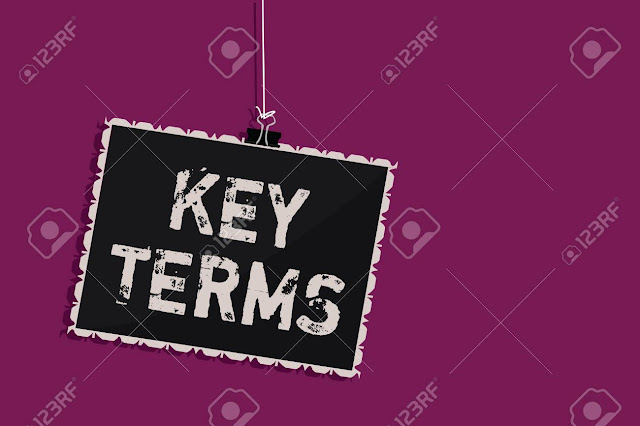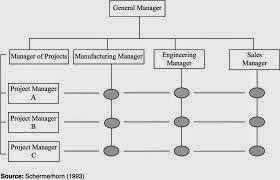20 KEY TERMS OF MANAGEMENT
1. Management
-
Planning, organizing, leading and,
controlling resources for the purpose of achieving organizational goals.
2.
Management
functions
-
Planning: Defining the goals as directed by executive
management; developing strategy; conceptualizing coordinated efforts.
-
Organizing:
Establishing the tasks that will achieve the goals; defining lines of
leadership; determining where decisions will be made.
-
Leading:
Motivating and directing subordinates; establishing effective
communications; resolving conflicts quickly and equitably.
-
Controlling: Ensuring tasks are accomplished as planned
and correcting deviations.
-
Organization:
A collective social unit that is goal oriented and formally
structured.
-
Performance: An organization’s actions that measurably
contribute to the achievement of organizational goals.
-
Efficiency:
The achievement of organizational goals with the minimal consumption of
resources.
-
Effectiveness: The extent to which an organization achieves
established goals.
3. Management skills
-
Technical Skills: The ability to apply specialized
expertise.
-
Human Skills: The ability to work with and motivate
individuals or groups of individuals.
-
Conceptual Skills: The ability to mentally analyze abstract
and/or complex challenges.
4. Core concepts
-
Organization: A coordinated group of individuals that
functions on a continuing basis for the purpose of achieving one or more
goals.
-
Executives:
Individuals who set organizational goals and policies.
-
Managers:
Individuals in an organization who achieve goals through subordinates.
Commonly referred to as administrators in non-profit organizations.
-
Supervisors: People who provide direct leadership over
line employees for the purpose of achieving management’s goals. Supervisors are typically individuals with
expertise in all of the tasks of their subordinates, and are generally promoted
from the ranks of the employees they oversee.
-
Workers:
Individuals employed to accomplish specific tasks for the purpose of
achieving the organizational goals set by executive management.
5. Management roles
Interpersonal
Roles
-
Figurehead: Symbolic chief; performs
routine ceremonial functions and solicitations.
-
Leader:
Directs and motivates subordinates.
-
Liaison:
Maintains internal and external contacts of individuals and groups that
are of benefit to the functioning of the organization.
Informational
Roles
-
Monitor:
Serves as central figure in obtaining and categorizing internal and
external information relating to the organization.
-
Disseminator: Communicates information obtained from
outside sources, as well as from subordinates, to appropriate members of the
organization.
-
Spokesperson: Transmits information relating to the
organization to external entities; is an expert in virtually all aspects of the
organization, as well as its respective industry.
Decisional
Roles
-
Entrepreneur: Scours the organization in search of
opportunities to bring about positive, if not profitable results.
-
Disturbance Handler: Implements corrective action to counter
important and unexpected turmoil within the organization.
-
Resource Allocator: Makes or approves important decisions, and
ensures they are adequately staffed and funded.
-
Negotiator: Represents the organization in
negotiations.
6. Activities of successful
managers
-
Traditional Management: Decision-making, planning, and
controlling.
-
Communication: Exchanging information and processing
paperwork.
-
Human Resource Management: Motivating, disciplining, staffing, training,
and resolving conflict.
-
Networking: Socializing, politicking, and interacting
with outsiders.
7.
The
learning organization:
An organization in which problem solving is encouraged at all levels
that results in increased operational capability.
Interwoven characteristics:
•
Leadership • Empowered employees •
Shared information • Horizontal structure •
Emergent strategy • Strong culture
-
Paradigm: A widespread and ingrained conceptualization
of the operational environment.
-
Paradigm shift: A change in environmental circumstances that
leads to an altered understanding of the world.
8. Evolution of the learning
organization
-
Classical perspective: Management philosophies that emerged in the
late 19th and early 20th century, embracing scientific and rational approaches
to forging efficient and productive organizations.
-
Scientific management: Management perspective that relied upon early
research and emphasized scientifically demonstrated measures to change
management and increase productivity.
9.
Bureaucratic
organizations:
Concept that touts
impersonal and rational management that is characterized by clearly defined
authority, meticulous record keeping, and separation of management and
shareholders.
10.
Administrative principles: Focused on the organization as a whole by
delineating planning, organizing, coordinating, and controlling.
11.
Humanistic
perspective:
Management philosophies that emerged concurrently with the classical
perspective that focused upon employee needs, behavior, and attitudes.
12.
The
human relations movement:
Sparked by the Hawthorne studies in 1924 and involved management in
focusing upon the basic needs of employees as the primary factor in increased
productivity.
13.
The human resources perspective: Philosophy that embraces designing jobs that
challenge employees to maximize their potential.
14.
Maslow’s
Hierarchy of Needs:
A hierarchy of five needs that represent human drive, based on the
premise that once a need is met, the next higher need becomes dominant. 1.
Physiological: Includes hunger,
thirst, and shelter. 2. Safety:
Includes security and defense from physical and emotional harm. 3.
Social: Includes affection,
acceptance, friendship, and belonging.
4. Esteem: Includes self-respect, autonomy, achievement,
status, recognition, and attention. 5.
Self-actualization: Is reached
when an individual become what he or she
or she is capable of.
15. Theory X and Theory Y .
Theory X:
Is the assumption that employees are inherently lazy, abhor work, and
must be coerced into performing.
Theory Y:
Is the assumption that employees enjoy working, desire responsibility,
and can work without direction.
16.
The
management environment:
All factors that exist within and beyond an organization’s boundaries
that can affect the organization.
17.
Internal
environment:
The environment within an organization’s locus of control.
• Employees
• Management • Organizational
culture
18.
General environment: The environmental layer that indirectly
influences the organization’s operations
• Technological • Socio cultural • Economic
• Legal • Political • International
19.
Task environment: The external layer of the management
environment that directly affects the organization.
• Customers
• Labor market • Suppliers • Competitors
20. Ethics in management
-
Ethics:
Code of moral values that govern the fundamental behaviors of
individuals, groups, and organizations.
-
Ethical dilemma: A condition that arises when a decision must
be made, and the alternatives are ethically undesirable, causing difficulty in
determining right from wrong.
-
Utilitarian approach: The ethical principle that morally positive
actions invariably result in overall good.
-
Moral-rights approach: States that moral decisions are best made by
those affected by them. Individualism
approach: The concept that acts are
moral when they serve in the best interest of the individual’s long-term
interests.
-
Justice approach: The concept that moral acts must be based on
equity and impartiality.
-
Distributive justice: States that people should be treated
according the differences between them.
-
Procedural justice: All ethics should be derived from clearly
defined rules that are consistently applied.



Comments